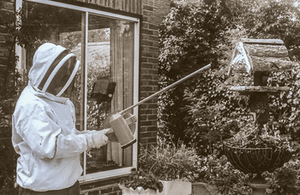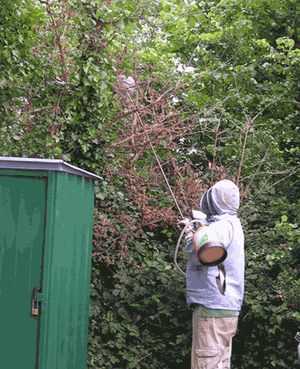How we treat and destroy wasp nests.
Wasp nests & Hornet nest treatment methods & wasp nest removal.
Please remember that during spring, wasp nests are small and manageable. However, as summer progresses and the nests expand with the help of numerous worker wasps, the situation becomes more serious.
We strongly advise against any attempts to knock down an active wasp nest or, in some extreme cases, set it on fire, as the consequences can be unpleasant. If a nest is disturbed, it may break apart rapidly and release its contents - in this case, a swarm of highly agitated wasps that may seek revenge.

Blocking Wasp Nest Entrances.
We advise against attempting to block the entrance to a wasp nest. We have encountered several instances where customers have used methods like duct tape or expanding foam to block nests, but the outcomes have not been positive. When wasps discover their nest entrance is blocked, they don't just give up and disappear; instead, they become agitated and look for alternative exits.
Wasps can chew through walls or ceilings; in the worst-case scenario, they may end up inside the house. Even if the entrance is blocked, the wasps will return to the nest and actively search for another way inside. Therefore, it's best to avoid using expanding foam or any other methods to try and exterminate a wasp nest or block its entrance, as it will likely create more issues than it resolves.
Setting fire to wasp nests.
It is highly recommended to avoid attempting to set a wasp nest on fire. This approach is not only ineffective in eliminating all the wasps, but it also poses a significant fire hazard. Moreover, it can provoke aggressive behaviour from the wasps, increasing the risk of stinging incidents. Wasps are very defensive of their nests, and anything that they perceive as a threat to the nest or their offspring can prompt an immediate attack.
Under duress, wasps release a pheromone that signals other colony members to join the defence, intensifying the aggression remarkably. Using such methods is not a comprehensive solution for wasp control. It only increases the danger and potential harm in addressing the issue. Opting for safer and more effective wasp nest management is highly recommended to mitigate risks and ensure a successful resolution.
Flooding/Drowning wasp nests.
It can be tempting to try and get rid of a ground wasp nest by inserting a hose into the hole, turning on the water and leaving, but this method is usually unsuccessful. The soil around the nest tends to absorb much of the water before it can reach the nest, resulting in a waterlogged lawn.
Professional wasp treatments usually involve using a powder-form product. However, applying dry powder to damp soil can create a paste-like substance that renders the insecticide useless. It is, therefore, essential to consider alternative strategies to deal with ground wasp nests to achieve better results while avoiding any potential negative impacts on the surrounding environment.
Professional treatments of Wasp nests.
If you have an active wasp or hornet nest on your property, we can help. Our intervention involves identifying the entrance points to the nest and applying a specialized insecticide as a white powder or a liquid. It's important to note that these insecticides are only available for professional use and not for the general public. The returning wasps then encounter the treated entrances, and they inadvertently carry the insecticide within the nest, contributing to the treatment's overall effectiveness.
In cases where locating the nest entrance is challenging or access is restricted, we may need to discover the nest and inject it physically with the insecticide. Nest treatments are typically done within the loft space of a building.
The insecticide we use is fast-acting, and the nest becomes inactive by the end of the day or even sooner, ensuring that all foraging wasps or hornets returning to the nest come into contact with the insecticide, effectively neutralizing the colony.
For safety reasons, we recommend that customers stay away from the treated wasp nests for a certain period after the application. Introducing the insecticide may occasionally temporarily agitate the wasps, so it's best to exercise caution during this brief post-treatment period.
Anaphylactic shock.
Wasp stings have the potential to cause Anaphylactic reactions in specific individuals, which can be life-threatening. However, many people are unaware of their susceptibility to anaphylaxis, which is an allergic reaction caused by various substances, including foods, medications, or insect venom. Therefore, the best approach is to avoid being stung by wasps in the first place, especially when dealing with their nests. The safest way is to hire professionals with specialized tools and protective clothing.
We have the necessary equipment to reach challenging wasp nest entrances safely. In cases where a wasp or hornet nest is located in a loft space without an external entrance, we use telescopic lances. These tools allow us to effectively treat the nest within the loft space without getting too close.
Handling nests in loft spaces can be tricky due to confined spaces and limited exit options. Relying on professional expertise and specialized equipment ensures a safer and more effective resolution while minimizing the risk of wasp stings and associated complications.
Wasp Nest Removal Service
We want to inform our customers that removing treated or naturally deceased wasp nests is usually unnecessary. The reason for this advice is straightforward. During the day, most adult wasps are out of the nest, foraging for food, water, and materials to build their nests. After a nest treatment, it takes time for these foraging wasps or hornets to return to the nest where the insecticide is present.
If we remove a nest before all the wasps have returned, there is a risk of a residue of wasps looking for the removed nest. Without a home, they may become agitated and, in some cases, attempt to rebuild the nest.
It is worth noting that most nests are left in their current position, as wasps do not reuse a nest from a previous colony or an old nest from the prior year. Occasionally, a new nest may be constructed next to an old one, usually because the location is deemed ideal by the wasps.
We have never encountered wasp nests that we could not treat.

Bee Swarm Treatments - relocation
Important Notice: Due to the decline in the population of native bees, we do not treat Honey Bee colonies.
If you come across a swarm of Honey Bees, we encourage you to seek out a local beekeeper or swarm collector, as they are typically willing to collect bee swarms free of charge.
It's worth noting that we do not treat Bumble Bees either. If you find them problematic, you can contact your local beekeeping society, which can guide you on relocating them without causing harm. Additionally, we do not treat Mason and Mining Bees as they do not pose any threat and are valuable pollinators known for their low likelihood of stinging.
